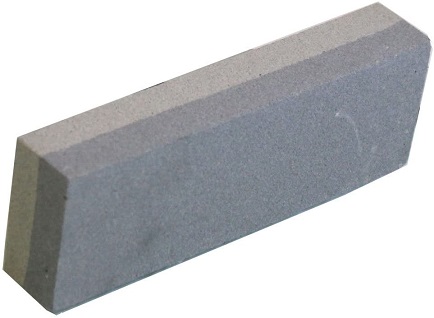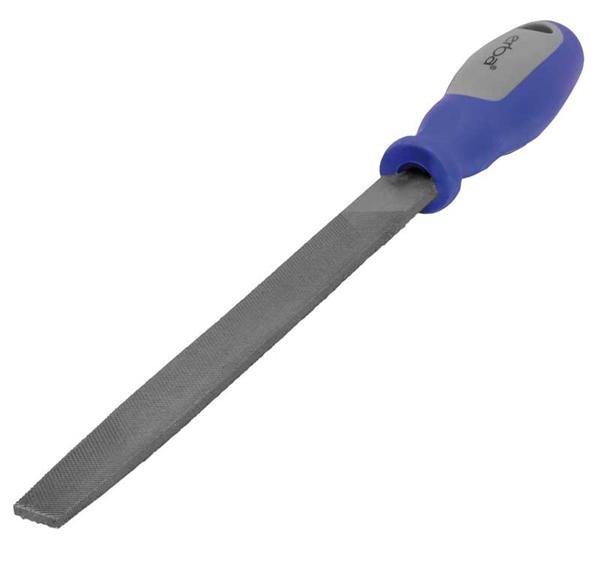|
| | Carbon steel vs stainless steel knives. |    |
| | Author | Message |
|---|
PaulRyckier
Censura

Posts : 4902
Join date : 2012-01-01
Location : Belgium
 |  Subject: Carbon steel vs stainless steel knives. Subject: Carbon steel vs stainless steel knives.  Wed 17 Feb 2021, 11:57 Wed 17 Feb 2021, 11:57 | |
| In my childhood I was the one, who had to turn the handle of the "water grindstone?" (waterslijpsteen) as help for my father, who was sharpening his knives for, as a fish merchant, cutting the fish. And yes on such a sandstone one as this one:  But the handle had wood on it (more easy for my hands) and the frame was not in cast iron. In that time I didn't want to give up and turned nearly till death  ...perhaps was that in preparation for later... But nevertheless, when I had other things to do later, I fixed the same water grindstone with a wheel instead of the handle and with a motor underneath... But my question was, perhaps for Meles?, who worked in the time in a steel producing factory, if I recall it well...and I still hear it my father say...grumping...bah...those stainless steel knives...nothing better than the old fashion carbon steel ones...that new "stainless steel" like "lead" ones and that difficult to sharpen and that quickly blunt after a time... Meles?... |
|   | | Meles meles
Censura

Posts : 5121
Join date : 2011-12-30
Location : Pyrénées-Orientales, France
 |  Subject: Re: Carbon steel vs stainless steel knives. Subject: Re: Carbon steel vs stainless steel knives.  Thu 18 Feb 2021, 10:42 Thu 18 Feb 2021, 10:42 | |
| Yes Paul, plain carbon steel blades can be made much harder than stainless steel ones, hence, although needing more effort to sharpen and being rather prone to "chip" if dropped or mishandled (and of course not being rust-proof), plain carbon steel knives will generally "hold their edge better", meaning that in use the edge is more resistant to wear and so the blade will stay sharp for longer.
It's a bit complex however I know you already have some knowledge of this and so I hope my explanation is understandable, both to yourself and to anyone else that's interested. I'm firmly of the belief that everything scientific (with the possible exception of quantum physics which often defies common-sense and logic) can be broken down and rendered comprehensible to anybody. Being unable to do so without resorting to jargon, prior assumptions or simplifying to the point of saying things that are factually untrue, should be seen as a personal failure and rather suggests one doesn't fully know one's subject. However, having now boldly set myself up for a fail on that score, in my defence it's not always easy to do so just using the written word: I really need to explain in person, using my hands and a blackboard ... plus a few 3D wire-and-ball crystal-structure models would be useful too. Nevertheless here we go ...
Steel, as a blanket term, means alloys based on iron, of which iron with a small amount of carbon is the most important group. Plain carbon steel is thus a binary iron-based alloy in which the second component is carbon and any other elements are basically as impurities at trace levels (although they may still have important effects). Just by adjusting the carbon content over the range 0.1 - 1.2%C it is possible to get very different microstructures and hence different combinations of mechanical properties. Adding increasing amounts of carbon to iron increases the strength and hardness although tending to reduce the toughness a bit. However for an effective cutting blade (at least to be better than anything the Bronze Age could manage) we really require a hardness far in excess of what can be obtained by simply increasing the carbon content.
It has been known since antiquity that a piece of carbon steel - that's refined iron containing just a bit, but not too much carbon - could be further hardened by a secondary heat treatment. This hardening was done by first heating the metal to redness and then rapidly quenching into water. At room temperature the stable (equilibrium) phases (ie the crystalline forms) present in the solid metal are body-centred cubic (BCC) iron (known as ferrite) together with iron carbide (known as cementite); while at temperatures above about 800°C there is only one stable phase, face-centred cubic (FCC) iron (known as austenite). FCC iron is capable of dissolving much more carbon than BBC iron, hence why only one phase is present at high temperature, as all the carbon is dissolved into the FCC iron (and by dissolve I mean the small-sized carbon atoms fit happily into the spaces between the regular FCC crystal array of the much bigger iron atoms). If the metal is then very rapidly cooled from this high temperature state, a metastable super-saturated solid solution is formed (known as martensite): the carbon atoms that were dissolved in the FCC iron do not get the time to diffuse and re-arrange themselves into separate carbide (cementite) crystals before the energy to move is gone (ie it's gone cold) and they are stuck in place. The crystal lattice is deformed and under strain by these carbon atoms being stuck where they shouldn't now thermodynamically be. As a consequence this martensite is supremely hard but very brittle. Some toughness can however be restored, albeit with a slight loss of hardness, by tempering: that is reheating to 300-600°C to partially transform the martensite into the equilibrium phases of BCC iron (ferrite) and iron carbide (cementite) but now with a very much finer distribution throughout the metal than if it had just been left to cool slowly. So much so good, and in practical terms this has been known, if not fully understood, for a few thousand years.
Plain carbon steel however is suceptible to atmospheric corrosion, ie it rusts in moist air (producing hydrated iron oxide). In the 19th century it was found that the addition of certain other elements, principally chromium, would impart corrosion resistance to the metal. This is due to the surface layer of chromium oxide which, unlike iron oxide, does not hydrate and so occupies the same volume as the metal it forms from, hence it forms a very thin, chemically inert, protective surface layer that is self-repairing as it forms rapidly when cut or scratched. To impart a reasonable degree of protection, at least to the atmosphere, requires at the very least some 12% of chromium, but then adding chromium in excess of about 20% tends to make the alloy unacceptably brittle. Usually for good corrosion resistance the chromium content might be around 16% but often with, say 8% or so, of nickel added as well, which gives even better corrosion resistance but without imparting so much brittleness.
However adding this amount of chromium and nickel changes the whole microstructure of the metal, such that the stable equilibrium form is now face-centred cubic (austenite) at all temperatures down to below room temperature. As there are now no different crystal structures between high and low temperature (capable of dissolving vastly different amounts of carbon) this austenitic stainless steel alone will not respond to a quenching heat treatment, and so however fast you cool it, it will never transform to martensite. This is the sort of stainless steel that might be used to make kitchen sinks, bathroom fittings, domestic appliances, saucepans, small screws and fastenings, some tools and even tableware, but since it will never be particulaly hard it is not at all suitable for kitchen knives, or not the blades anyway. Incidentally you can test whether a stainless steel is austenitic, as opposed to other grades, as it will not attract a magnet.
To get a stainless alloy that will respond to hardening generally requires the chromium to be kept low, the nickel very low or completely absent, and the carbon to be higher than in an equivalent austenitic stainless steel. These additions also slow down the martensitic reaction so these sort of alloys can often be air quenched, ie cooling in air is usually fast enough to form martensite. However the subsequent tempering process to impart toughness is complicated by the high carbon content and so this typically requires small but critical additions to the alloy of molybdenum, tungsten, niobium or silicon, which serve to control the formation of the carbides. The low chromium and nickel contents, together with high carbon content does also lower the corrosion resistance, particularly to salt water, and so they are only suitable for mild ambient conditions.
Most stainless kitchen knives are made from such hardenable stainless steel but as you'll now appreciate their performance is dependent on much more than the comparatively straight-forward hardening and tempering treatment alone. Given that we are now dealing with a ternary Fe-Cr-C alloy with further small critical additions of maybe three or four more elements, and the critical control of yet more undesirable impurities, there are many different grades in this family of hardenable stainless steels. With careful selection of composition and treatment it is possible to get a stainless alloy with a very good combination of hardness, strength and toughness, comparable to a good plain carbon steel, but generally the hardness of a stainless steel is significantly lower for the same strength/toughness. Hence many stainless steel knives do not "hold their edge" as well as plain carbon steel knives. As so often in life, while we can never get the best of all worlds and so some compromise is necessary, with any type of steel it is the grade and quality - and accordingly the price - that is all important. At the end of the day you gets what you pay for.
Last edited by Meles meles on Thu 18 Feb 2021, 15:38; edited 5 times in total (Reason for editing : typos - the couple of really serious factual errors I'd already corrected long before your reply) |
|   | | PaulRyckier
Censura

Posts : 4902
Join date : 2012-01-01
Location : Belgium
 |  Subject: Re: Carbon steel vs stainless steel knives. Subject: Re: Carbon steel vs stainless steel knives.  Thu 18 Feb 2021, 14:38 Thu 18 Feb 2021, 14:38 | |
| Thank you so much for this comprehensive explanation Meles, which covered I suppose every aspect of the question and in detail. And I read it all! Perhaps as I worked also in a big factory constructing agriculture machinery using tons of steel. I was rather the specialist of the organic protection of that steel. The specialist of the steel control was my friend as we both were a bit in the chemical field. But for both of us it was not so much chemical as rather physical tests on the behaviour of that steel and the coating. After his sudden death, there was some parlance to make a joint of the two, but I and my bosses wisely did't accept the proposition as both my boss and I felt not competent enough in the steel field...and yes against the suppliers, especially the "strong" ones, it was not easy to go against their "statements", which had to do with money and influence, even to the bosses above you...
Meles, thanks again for solving that lifelong question of me. And yes I could asked it to my friend of the "steel" control, but our two labs were nearly I guess one km (3/4 of a mile?) from each other and en plus we were depending from two different departments and as I knew his background (we had both have been to the same school that was more focused on plastics) I was better prepared for my job than him. And BTW we learned both our typical knowledge by on the spot learning and information of both the respective suppliers. And at the end we became perhaps specialists in our respective fields. And after the death of the steel specialist, his place became changed to a non-specialist, who only did the controls and in case of discussion it was perhaps given to an independant labo I guess. For me when I grew through, the lab remained with me but now with a chemical engineer.
And Meles today I learned a lot from you. Kind regards, Paul. |
|   | | Meles meles
Censura

Posts : 5121
Join date : 2011-12-30
Location : Pyrénées-Orientales, France
 |  Subject: Re: Carbon steel vs stainless steel knives. Subject: Re: Carbon steel vs stainless steel knives.  Thu 18 Feb 2021, 16:47 Thu 18 Feb 2021, 16:47 | |
| By the way Paul, in my opinion you shouldn't really ever use a grind-wheel, such as you pictured above, to sharpen a kitchen knife. A round grind-wheel like that will inevitably acquire a slightly concave surface - and so while it might be sufficient for putting an edge or point on to a chisel for cutting stone or metal, to an axe for chopping down trees, or even to a sword so long as you just intend to do nothing more sophisticated than simply hack and bash your opponent - it would not be so good if you want a really sharp, precision blade, such as is required by barbers, surgeons, hairdressers, seamstresses, as well as more discerning butchers and cooks. Such people would usually use a flat whetstone (as below) to sharpen their tools, or get them professionally "hollow ground" (but that's something slightly different again). Knife-sharpening was often done by itinerant knife-grinders in the street, but that is not to say it was just casual, inexpert work. They had the equipment to do the job properly. Moreover they must have been seen as providing an important and needed service, better than anything domestic servants could do at home, otherwise they' d have had no business..  Using a oil stone like that my father used to be able to get mum's carving knife, which was sharpened each week in anticipation of Sunday lunch, sharp enough to cut through a single sheet of newspaper when lightly drawn along the blade. But then the blade itself was of a very high grade, high carbon, hardened steel, of almost surgical or razor quality and accordingly very, very hard - but also rather brittle, perhaps somewhat impracticably and unforgivingly so - and also of course it was not rust-proof. If the carver ever twisted the blade just slightly while pushing down, the blade edge was liable to break - probably just a tiny half-moon piece of the cutting edge would snap off but it would require the whole blade to be carefully re-ground. I still sharpen my kitchen knives (all but one are in stainless steel and are nothing very fancy or expensive at all) slowly and very carefully using a flat stone lubricated with oil rather than water. Quite frankly I think the so-called 'celebrety chefs' that one sees - flamboyantly whipping their carving knives up and down the pointy "sharpening steel", with casual abandon but without any care to the actual angle between blade and sharpener - should all be guillotined with a suitably blunt blade, for crimes against cooks, butchers, knife-makers and metallurgists. |
|   | | PaulRyckier
Censura

Posts : 4902
Join date : 2012-01-01
Location : Belgium
 |  Subject: Re: Carbon steel vs stainless steel knives. Subject: Re: Carbon steel vs stainless steel knives.  Fri 19 Feb 2021, 13:17 Fri 19 Feb 2021, 13:17 | |
| Thank you Meles for all this additional information. And yes later on I became aware about that oval becoming of a circular water grinding sandstone and a butcher once hinted at your flat grinding stone method. But yes in our household, I doing the work and the kitchen for us two and even in these days of Covid 19 isolation and nearing the eighties I am still busy also with the "for hire" and refurbishing, now in "onderaanneming" (sous-traitance, subcontracting) and even that needs a lot of coordinating... Hence the obligation for efficiency...also in the kitchen...and yes ecology... For instance the "washing-up?" doing it in the largest recipient from the cooking...a drop of detergent...and rinsing each piece with a bit of hot water from the watertap...and putting it wet on the sink... But back to stainless knives... I bought once a "gekarteld mes" (don't know the translation) and the shop lady said that I would use it for everything and by its quality I would have it forever. I use it mostly for cutting tomatoes in the "hand?" (we use big quantities of them) and indeed have it yet for years...  And for the cutting of potatoes and all we use a "potato knife?" and yes for all the rest, even cutting beef and all in the dinner plate...nobody is watching... And that "potato knife"  I sharpen, you don't believe it, first with a "fine "ijzervijl" (didn't found an english translation)  All to do it quick... And then indeed with a bit of water on a flat stone...but not too long...time is money... And as an aside Meles, and about B&Bs as from the former daughter-in-law in Bruges, be prepared for an "explosion" after the jabs and Covid-time...  ...and you will need efficiency that you already had I presume, but certainly for time...also in your "cuisine"... Kind regards from Paul. |
|   | | Sponsored content
 |  Subject: Re: Carbon steel vs stainless steel knives. Subject: Re: Carbon steel vs stainless steel knives.  | |
| |
|   | | | | Carbon steel vs stainless steel knives. |    |
|
Similar topics |  |
|
| | Permissions in this forum: | You cannot reply to topics in this forum
| |
| |
| |
